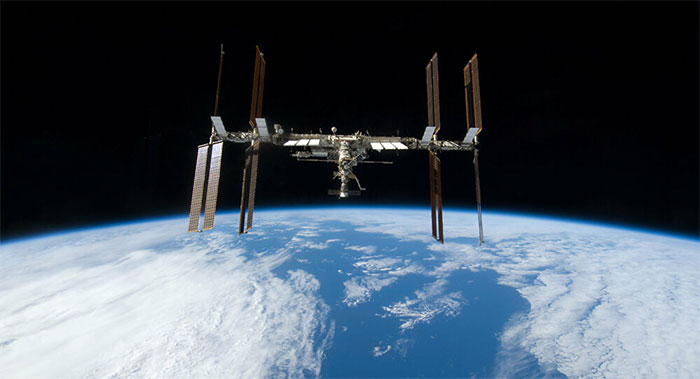How to bring the International Space Station back to Earth?
If you are wondering, it's true that we can bring the International Space Station (ISS) back to Earth. However, it will only be a mixture of mixed molten metal!
How did ISS return to Earth?
To understand why this is so, first of all, we need to know some information including the forces, orbit, and gravity.
How did people put ISS into space?
The International Space Station is about the size of a football field. Because it is so large, it cannot be launched into space with just one flight.

It took astronauts more than 10 years to assemble the ISS into space.
In fact, NASA's space shuttle took 37 flights to get most of the ISS components up to 350km above the ground - an altitude equivalent to 3,850 football fields overlap. And it took the astronauts more than 10 years to assemble the ISS into space.
Why did ISS not fall to Earth?
To understand why ISS can fly in space without falling to Earth, you need to know about the forces.
You cannot see the force, but you can feel it. Force can make things move, and cause them to stop moving.
There are two different forces that help keep the ISS in space . The first is gravity. Very heavy things (like planets) create a force that pulls smaller things (like you) towards them. The reason we don't float in the sky (and also the reason you fall back into the sky) is because the gravity of the Earth always pulls us to the ground.
When the astronauts flew away from Earth, they floated because they were free of gravity. But why doesn't gravity pull the ISS back to Earth?
To answer that question, we must know about another force called centrifugal force. When something moves in a circle, centrifugal forces push them away from that circle. You can feel this when playing a carousel in the park, or when you ride through a bend and are forced into the car door.
ISS moves in a circle around the Earth at a sufficient speed. The centrifugal force pushes it away with the same gravity pulling it to the ground. This equilibrium is called a stable orbit . And unless something happens and changes it, the ISS will continue to move as usual.

The area where the ISS is likely to fall.
Can we bring ISS back to Earth?
When will ISS actually return to its "motherland"? We don't know yet. But most likely that will happen after 5 years from now.
When the astronauts from ISS returned to Earth, they walked in small cabins like the ones they had used to get there. It can hold 3 people, and a few other errands. It's certainly not big enough to fit into the ISS, even if we split this space station into small pieces. So what happens when we no longer use ISS?
Some of its parts will probably be kept in space for reuse for a new space station. But most of the ISS will return to Earth. To do this, mission operators (ISS operators) will use station-mounted missiles to drive it closer to Earth. When close enough, gravity will begin to pull the ISS down.
When the station enters the atmosphere (the layer of air surrounding the Earth), it will ignite. The cause comes from another kind of force called friction, which occurs when two things slide on each other at high speed. Friction makes everything hot.
Once the ISS has passed through the atmosphere, it will most likely fall into an empty area in the Pacific Ocean, called the "Oceanic Pole of Inaccessability" . This is one of the most vacant places on Earth, located between New Zealand and Antarctica. Other space stations, such as Russia's Mir station, are here, at a depth of 4km below sea level.
- NASA opened the International Space Station for ... tourists and film makers from 2020
- Russia will bring three astronauts on the ISS to Earth
- Looking back at the ISS space station after 15 years of operation
- The uncertain future of the ISS space station when NASA returns to the Moon
- International Space Station increased the orbit by 1.5km
- Space station increased in height to catch Soyuz
- The International Space Station completes the 100,000th rotation around the Earth
- Visit 'the longest road' on the ISS International Space Station
- Breathtaking view of space from the International Space Station
- Russia delayed two flights to bring people to space
- Astronauts return to Earth safely
- How big is the International Space Station (ISS)?
 Van Allen's belt and evidence that the Apollo 11 mission to the Moon was myth
Van Allen's belt and evidence that the Apollo 11 mission to the Moon was myth The levels of civilization in the universe (Kardashev scale)
The levels of civilization in the universe (Kardashev scale) Today Mars, the sun and the Earth are aligned
Today Mars, the sun and the Earth are aligned The Amazon owner announced a secret plan to build a space base for thousands of people
The Amazon owner announced a secret plan to build a space base for thousands of people